In a sense, owls are in a class of their own. These fascinating birds have unmatched eyesight and hearing capacity.
Over 200 owl species exist, with the United States being home to 19.
Due to the high number of variants within a species, it can be hard to identify an owl at first glance. Owl species have unique characteristics if you are lucky enough to be able to examine them for longer than an instant. Diversity in size and form is one of the hallmarks of the owl family.
Barred owls and snowy owls are two very different owl species. These two species have more differences than similarities.
Please keep reading to learn the differences between a barred owl and a snowy owl. Let’s dive in!
Table of Contents
What’s the Difference Between a Barred Owl and a Snowy Owl?
Several distinct features differentiate a barred owl from a snowy owl. Let’s look at their unique characteristics.
Snowy Owl Identification
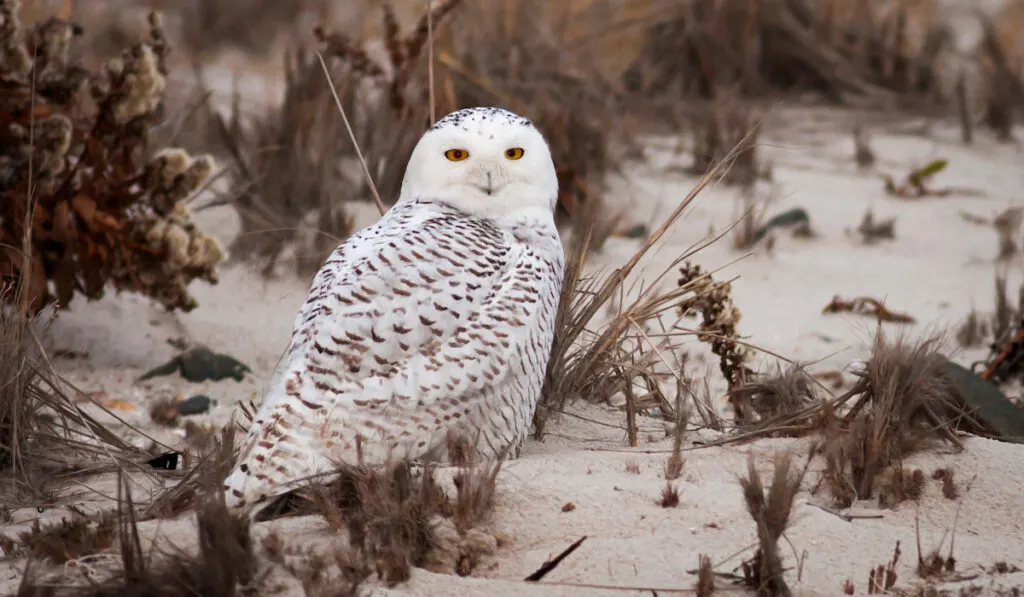
A snowy owl goes by several other names, like polar, white, or Arctic owl. This large white bird with a black beak and golden eyes is easily recognizable.
When sitting on the ground, the bird seems broad at the base. This appearance is due to the massive body and profuse feathering on the legs.
Despite being one of the world’s most distinctive owls, locating them in the field can be challenging because of their remarkable camouflage.
Being white helps the snowy owl blend in well with the surrounding snowy landscape.
Females and young birds show some black scalloping. On the other hand, the adult male is almost purely white.
These birds typically spend the winter in southern Canada and the northern United States.
Barred Owl Identification
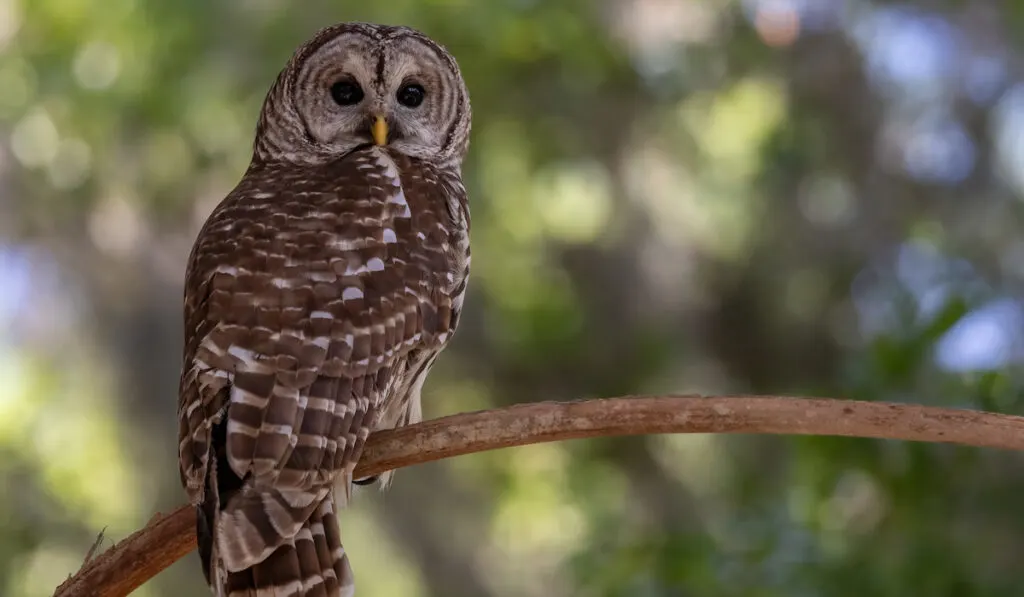
Compared to snowy owls, barred species are medium to large stocky owls with rounded heads. They have no ear tufts, are medium-length, and have rounded tails.
Barred owls have distinctive brown, grey, and white plumage. Also, they have bar-like vertical stripes, hence their name.
The head, back, and wings have a complex pattern of more profound white and brownish-grey bars. They fly silently because of their delicate feathers.
Moreover, you can quickly notice comb-shaped edges on their wings.
Barred owls spend the day sleeping soundly in forest trees. They hunt tiny animals at night, particularly rodents.
The habitat of the barred owl is a sizable, mature forest with deciduous and evergreen trees.
The table below shows some significant differences between snowy and barred owls.
| Trait | Snowy owl | Barred owl |
| Scientific name | Bubo scandiacus | Strix varia |
| Size | Large | Medium-sized |
| Color | White | Brownish grey |
| Habitat | Open tundra | Mature mixed forest |
| Wingspan | 15-18 inches (39-45 cm) | 14 inches (35 cm) |
| Length | 20-28 inches (53-71 cm) | 17-20 inches (45-50 cm) |
Barred Owl vs. Snowy Owl — Size
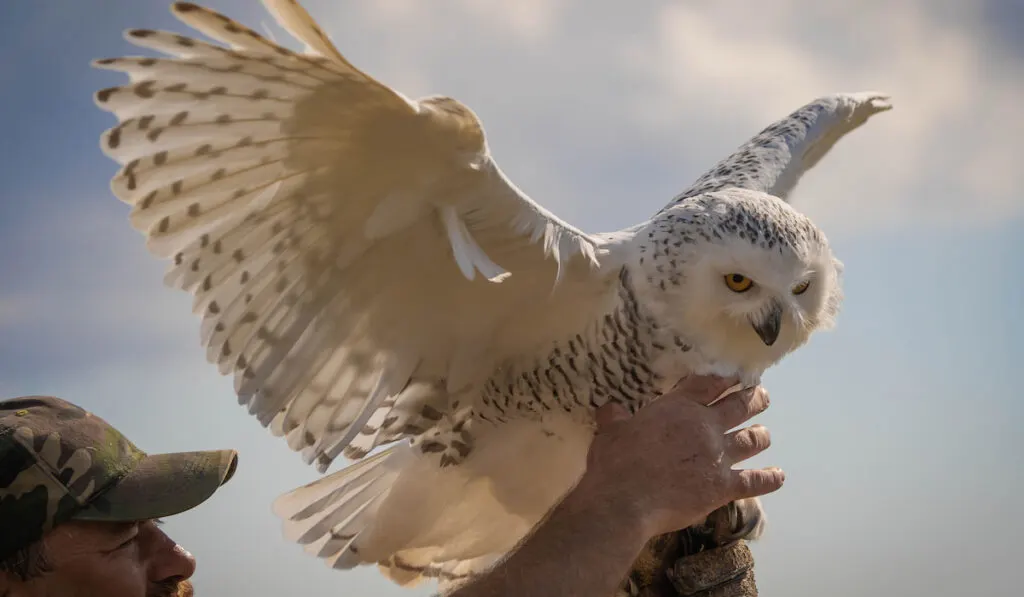
Snowy Owls are giant, white birds with round faces and piercing yellow eyes.
They are indigenous to the Arctic tundra. Although, during irruptions, you can find them further south, as far as Florida.
Barred owls have brownish-gray bodies with noticeable vertical stripes on their breasts.
Compared to snowy owls, the barred owls are medium-sized. You can locate them mostly in eastern and central North American forested areas.
Barred Owl vs. Snowy Owl — Habitat
Regarding habitat, barred owls inhabit woodlands. They live in mature forests with deciduous and evergreen trees close to water.
In contrast, snowy owls often live in the open tundra. These species prefer open spaces where they can easily see lemmings and other small prey.
Barred Owl vs. Snowy Owl — Calls
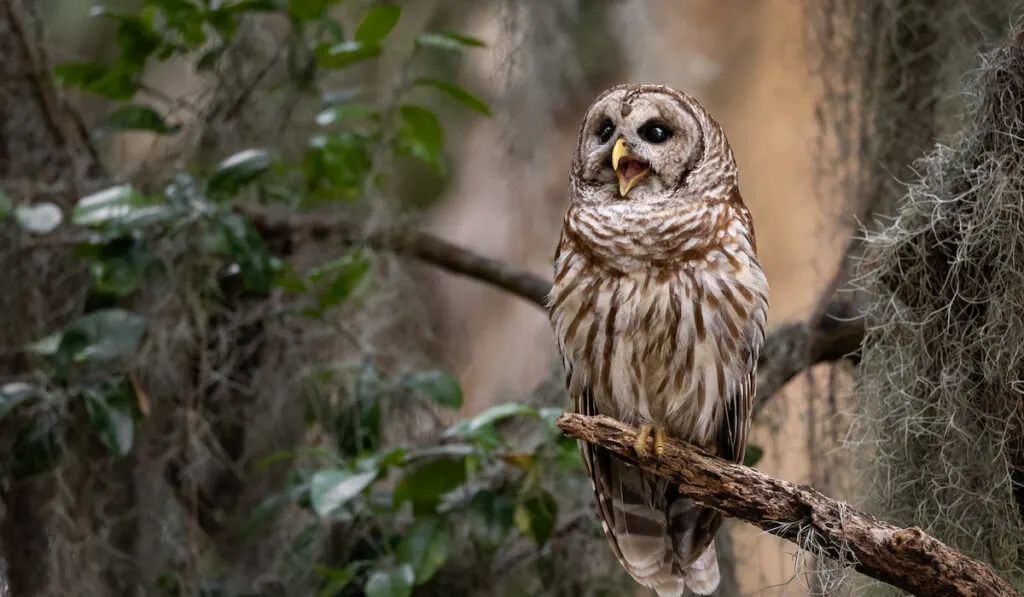
The two birds also have different calls.
Barred owls have what is considered a classic owl sound. These vocal abilities mimic human screaming, hissing, cackling, or wicked laughing. They can be calming or simply terrifying.
On the other hand, snowy owls make a powerful low, raspy hoot.
Barred Owl vs. Snowy Owl — Hunting Style
While barred owls hunt at night, the snowy owl frequently eats during the day. It keeps a constant eye on its surroundings from a low perch.
When it spots or hears movement, it swoops down to capture food with its talons.

How Rare Is the Snowy Owl?
You are only likely to see snowy owls if you reside in one of the northernmost states. Although uncommon, snowy owls are not rare.
During the winter, birdwatchers can see them close to meadows and fields with robust rodent populations.
If you reside inside the snowy owls’ migration zone, you can see them immobile on fence posts.
They prefer areas next to pasture or grassland regions throughout the winter.
Snowy owls are native to the Arctic and are distinguishable by their unusual look.
When food is scarce in their regular habitat during irruptive years, they will occasionally travel further south. For example, you can spot them outside their typical range in North America.
In the summer, the birds often return to the Arctic.
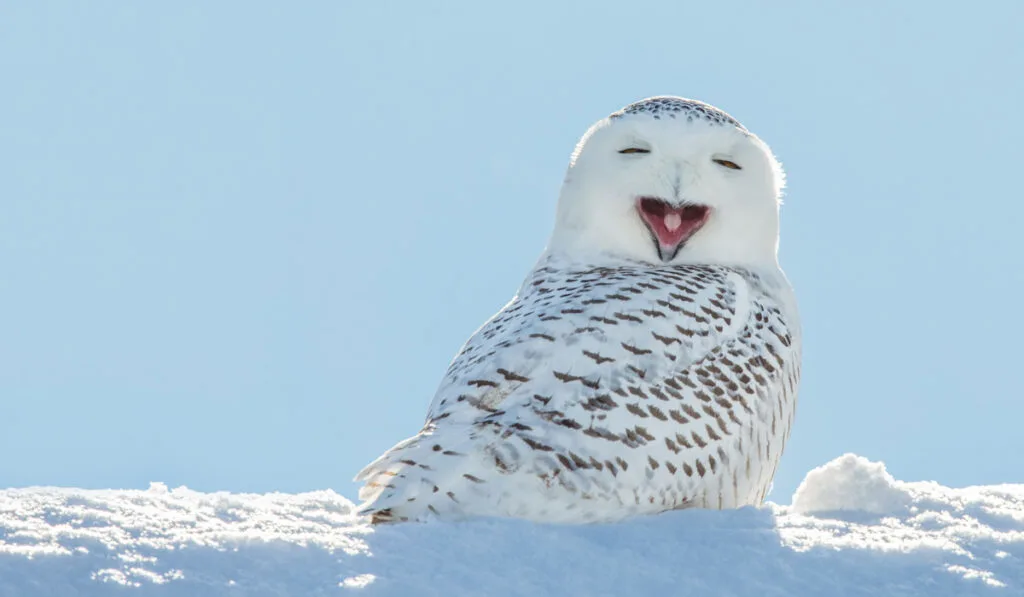
Are Snowy Owls Friendly Compared to Barred Owls?
Snowy and barred owls have varying temperaments and behaviors, which affect their friendliness. Snowy owls are less pleasant or friendly than barred owls.
They are wild birds and tend to be suspicious of people.
As cautious, lone predators, these birds frequently perch on low trees or fence posts. They will remain still and listen for prey.
The snowy owl is a raptor that isn’t drawn to your yard by bird feeders. When feasible, they will want to stay away from people all the time.
If you approach them close enough, they may become agitated.
The opposite is true for barred owls, considered more tolerant of human presence. These birds may even come to you in a quest for food.
Barred owl species are open to human-populated areas. But prefer hollowed-out spaces for nesting.
Due to their natural interest in people, barred owls select trees relatively close to human habitations. For example, a young, barred owl could choose to live next door if you put a lovely nest box in a robust tree.

Are Snowy Owls Rarer to See?
Depending on your location, snowy owls can be a rare sighting. These birds are native to the Arctic regions.
However, some snowy owls may move to more temperate areas during the winter. If you are close to these places, you may spot them more regularly, though they can still be elusive.
In the winter, you can seek snowy owls in agricultural fields, airport grounds, lakes, and the ocean shorelines. Still, they can be tougher to spot in the Arctic environment and are considered a rare sighting.
Breeding is most prevalent in years when lemmings are in great abundance in the polar areas.
What Is Special About Snowy Owls?
Snowy owls are notable for several reasons, including:
Snowy Owls Have a Unique Appearance
White feathers and bright eyes give snowy owls their unique look. These features make them easier to identify.
The claws and incredibly dense white feathering on the snowy owl’s toes contrast with its black feet.
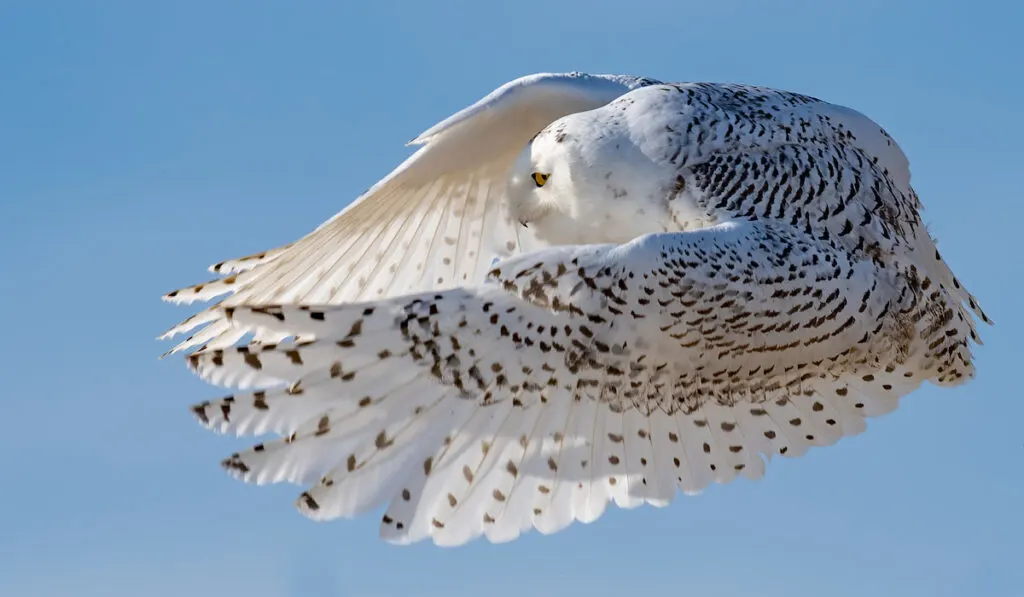
Snowy Owls Are Adaptable to Harsh Conditions
Snowy owls have a unique set of survival abilities. These skills allow them to flourish in the Arctic habitat and in severe weather conditions.
Snowy Owls Are Predators
Snowy owls are the top predators in their habitat.
This predator status is crucial to preserving the stability of the Arctic food chain.
Snowy Owls Are Famous for Their Irruptive Migration
Snowy owls are rare for birdwatchers due to their erratic migration patterns. They can go far south of their typical area during irruptive years.
Snowy Owls Have a Cultural Significance
Since ancient times, snowy owls have captivated people’s attention. They have appeared in mythology, folklore, and popular culture, including the Harry Potter books.
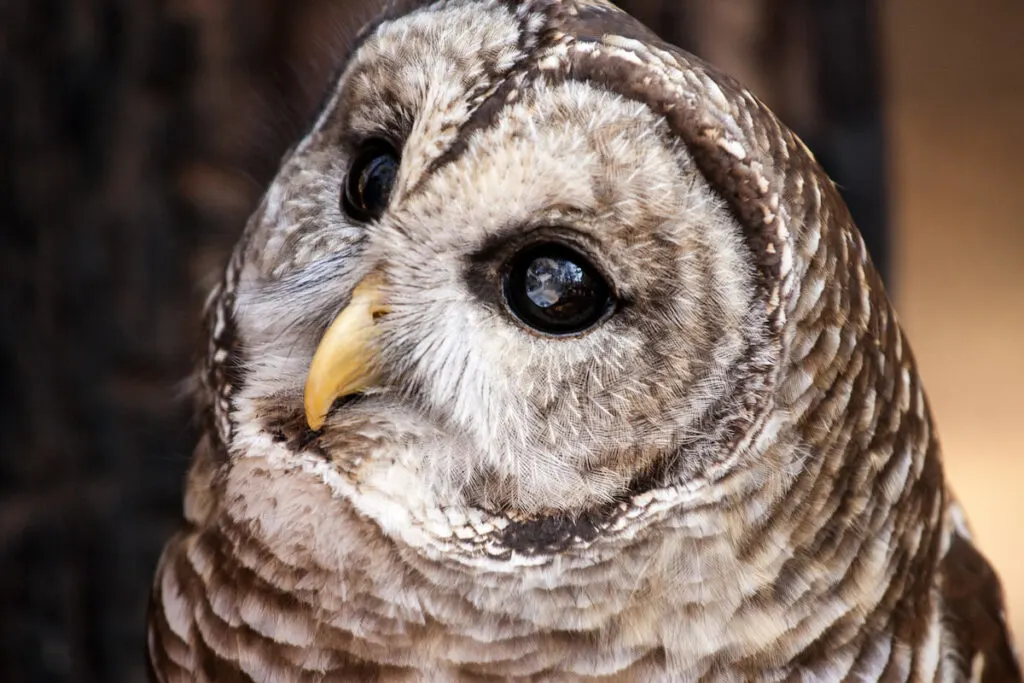
What Is Special About Barred Owls?
Several factors can explain the unique nature of barred owls. Some of them include the following:
Barred Owls Have a Unique Appearance
The unique brown and white striped feathers, prominent, rounded cheeks, and black or orange eyes are distinctive features.
Barred Owls Have Outstanding Vocalization
They stand out for their hooting cry, consisting of eight to nine hoots. Their distinctive “hooting” is the benchmark for a typical owl sound.
Barred Owls Are Adaptable to Diverse Conditions
Barred owls can survive in diverse habitats, including woods, wetlands, and urban areas. They are very adaptable birds.
Barred Owls Are Skilled Hunters
These birds are skilled predators who stalk their prey at night. They use their stealthy flying, razor-sharp claws, and keen vision for hunting.
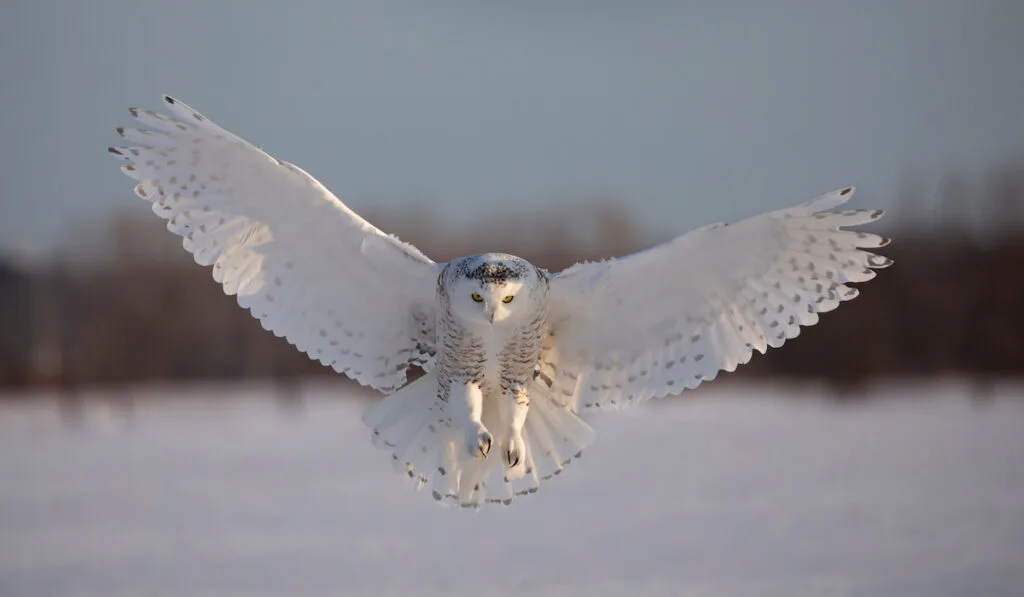
Are Snowy Owls More Aggressive Than Barred Owls?
Since they are suspicious and timid, snowy owls try to minimize their interaction with people. If they feel endangered, they could grow agitated and protect their area.
Barred owls are often more accepting of human presence. They are less likely to act aggressively against humans.
Final Thoughts
You can easily differentiate a snowy owl from a barred owl based on size and appearance.
Snowy owls are large birds with softly rounded heads that seldom display ear tufts. They inhabit the tundra and spend much of their lives on the ground.
Snowy owls lack the skills or instincts necessary to thrive in diverse habitats.
Barred owls spend the day sleeping peacefully in forest trees, hunting tiny animals at night. They prefer big woods with deciduous and evergreen trees.
These tips will help you differentiate the two owl species and enjoy your bird-watching experience!
